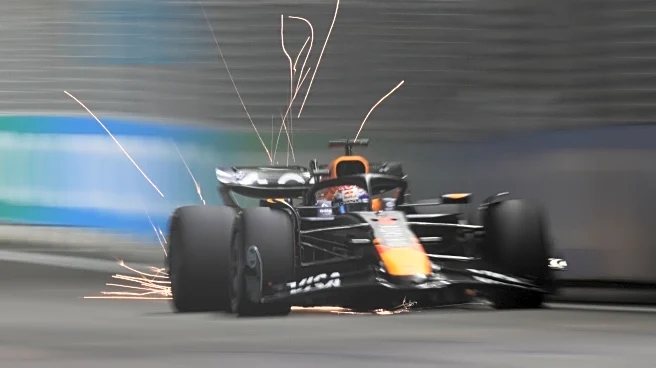What is the story about?
What's Happening?
Max Verstappen, a prominent Formula 1 driver for Red Bull, is set to challenge his title rivals at the Singapore Grand Prix. Starting from second on the grid, Verstappen aims to extend his winning streak after victories in Italy and Azerbaijan. The race sees Mercedes' George Russell on pole position, with McLaren drivers Oscar Piastri and Lando Norris starting third and fifth, respectively. Verstappen expressed frustration over missing pole position due to Norris's slower pace during qualifying. This race marks the first time the FIA has declared an F1 event a 'heat hazard,' highlighting the challenging conditions drivers face in Singapore's heat and humidity. Despite the conditions, Verstappen has opted not to use a cooling vest, a choice some drivers have made to cope with the heat.
Why It's Important?
The Singapore Grand Prix is a critical event in the Formula 1 calendar, with significant implications for the championship standings. Verstappen's performance could further solidify his position as a leading contender for the title, impacting the strategies of rival teams like Mercedes and McLaren. The race's designation as a 'heat hazard' underscores the evolving safety considerations in motorsport, potentially influencing future regulations and driver preparations. The outcome of this race could shift the competitive dynamics among top teams, affecting sponsorships, team morale, and fan engagement.
What's Next?
As the race unfolds, teams will need to adapt their strategies to the challenging conditions, with potential impacts on car performance and driver endurance. The results could influence team decisions in upcoming races, particularly regarding car setups and driver support systems. Stakeholders, including team principals and sponsors, will closely monitor the race's outcome to assess its impact on the championship race and future investments.
Beyond the Headlines
The Singapore Grand Prix's 'heat hazard' status highlights broader discussions about climate conditions in motorsport. This development may prompt the FIA and teams to consider more robust measures for driver safety and car performance in extreme weather conditions. Additionally, the race serves as a test case for how teams manage environmental challenges, potentially influencing future race locations and scheduling.
AI Generated Content
Do you find this article useful?














